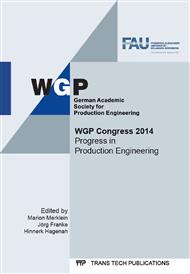[1]
G. Schuh, V. Stich, Produktionsplanung und -steuerung 1, 4. Aufl., Springer, Berlin, Heidelberg, (2012).
Google Scholar
[2]
H. -P. Wiendahl, T. Harms, J. Lopitzsch, Erfolgreich Planen - Fabrikstrukturierung und Logistikkonzeption im Einklang, in: H. Albach, Wiesbaden, Gabler, 2002, pp.199-217.
Google Scholar
[3]
H. Lödding, Verfahren der Fertigungssteuerung. 2., erweiterte Auflage, Springer, Berlin, (2008).
Google Scholar
[4]
G. Schuh, T. Potente, C. Thomas and C. Hausberg, Restructuring of Production vs. Continuous Improvement Processes - How to Increase Production Performance, 24th Annual POM Conference Denver, Colorado, USA May 3 – 6, Michigan State University, East Lansing (MI), (2013).
Google Scholar
[5]
G. Schuh, T. Potente, C. Thomas and C. Hausberg, Approach to determine the performance limits of production structures, The 11th international symposium of measurement technology and intelligent instruments, 11. Auflage, Apprimus, Aachen, (2013).
Google Scholar
[6]
K. K. Yang, A comparison of Reorder Point and Kanban policies for a single machine production system, Production Planning & Control, Vol. 9 (1998) 385-390.
DOI: 10.1080/095372898234118
Google Scholar
[7]
L. M. Roderick, J. Toland et al., A Simulation Study of CONWIP versus MRP at Westinghouse, Computers and Engineering, Vol. 26 (1994) 237-242.
DOI: 10.1016/0360-8352(94)90058-2
Google Scholar
[8]
J. Geraghty, C. Heavey, A review and comparison of hybrid and pull-type production control strategies, OR Spectrum, Vol. 27 (2005) 435-457.
DOI: 10.1007/s00291-005-0204-z
Google Scholar
[9]
J. A. Muckstadt, S. R. Tayur, A comparison of alternative kanban control mechanisms. II. Experimental results, IIE Transactions, Vol. 27 (1995) 151-161.
DOI: 10.1080/07408179508936727
Google Scholar
[10]
M. Huang, D. Wang, et al., A simulation and comparative study of the CONWIP, Kanban and MRP production control systems in a cold rolling plant, Production Planning & Control, Vol. 9 (1998) 803-812.
DOI: 10.1080/095372898233579
Google Scholar
[11]
J. -A. Pettersen, A. Segerstedt, Restricted work-in-process: A study of differences between Kanban and CONWIP, International Journal of Production Economics, Vol. 118 (2009) 199-207.
DOI: 10.1016/j.ijpe.2008.08.043
Google Scholar
[12]
S. Gstettner, H. Kuhn, Analysis of production control systems kanban and CONWIP, International Journal of Production Research, Vol. 34 (1996) 253-273.
DOI: 10.1080/00207549608905087
Google Scholar
[13]
W. G. Gilland, A simulation study comparing performance of CONWIP and bottleneck-based release rules, in Production Planning & Control, Vol. 13 (2002) 211-219.
DOI: 10.1080/09537280110069784
Google Scholar
[14]
S. -G. Koh, R. L. Bulfin, Comparison of DBR with CONWIP in an unbalanced production line with three stations, International Journal of Production Research, Vol. 42 (2004) 391-404.
DOI: 10.1080/00207540310001612026aa
Google Scholar
[15]
H. -G. v. Wedemeyer, Eine Zielfunktion der Produktionssteuerung zur Analyse und Bewertung von Fertigungsabläufen, in: D. Pressmar, et al. (Eds. ), Operations Research Proceedings, Springer, Berlin, Heidelberg, 1989, p.477–482.
DOI: 10.1007/978-3-642-74862-2_124
Google Scholar


